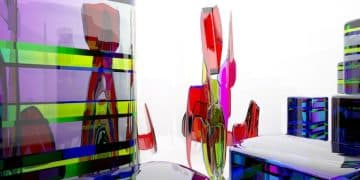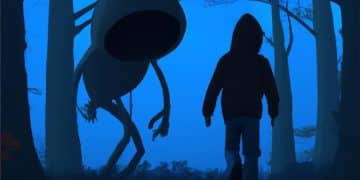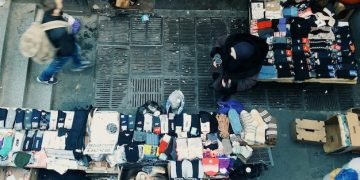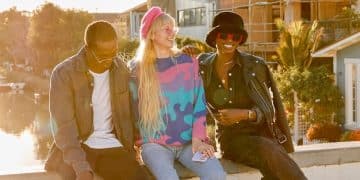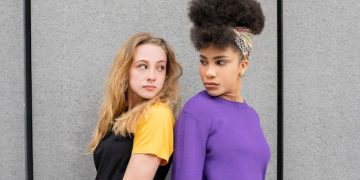Glitch Art in the US: From Digital Errors to Mainstream Art in 2025
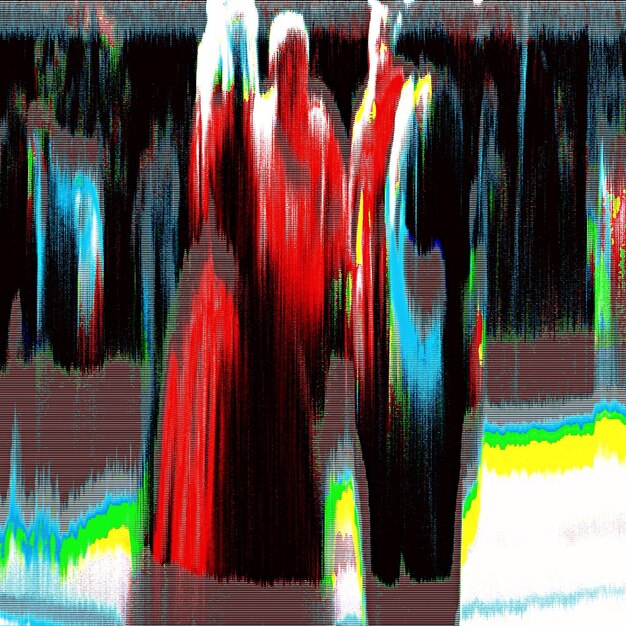
Glitch art, once a niche subculture celebrating digital errors, is increasingly recognized as high art in the US, influencing aesthetics and challenging traditional artistic boundaries, with its impact expected to grow significantly by 2025.
Glitch art, born from the accidental imperfections of digital systems, is no longer confined to the fringes of artistic expression. Its journey into the mainstream, particularly in the US, is transforming how we perceive art and technology.
What is Glitch Art? An Introduction
Before delving into its mainstream appeal, it’s crucial to understand what exactly constitutes glitch art. It’s more than just random digital noise; it’s a deliberate exploration of errors and imperfections within digital media.
The Origins of Glitch Art
Glitch art, in its simplest form, is the aestheticization of digital or analog errors. These errors can manifest in various forms, from visual distortions to audio disruptions.
Techniques Used in Glitch Art
Artists employ a range of techniques to create glitch art, including data bending, where files are manipulated using text editors or other software, and hardware manipulation, which involves physically altering devices to produce errors.
- Data Bending: Modifying file code to create visual and auditory distortions.
- Hardware Manipulation: Physically altering devices to induce errors.
- Software Exploitation: Utilizing software bugs and vulnerabilities for artistic purposes.
- Intentional Corruption: Purposely corrupting digital files to achieve desired glitch effects.
Glitch art challenges our expectations of flawless digital performance, prompting us to find beauty in the unexpected. Its roots can be traced back to the early days of computing and video art, where experimentation with technology was a core principle.
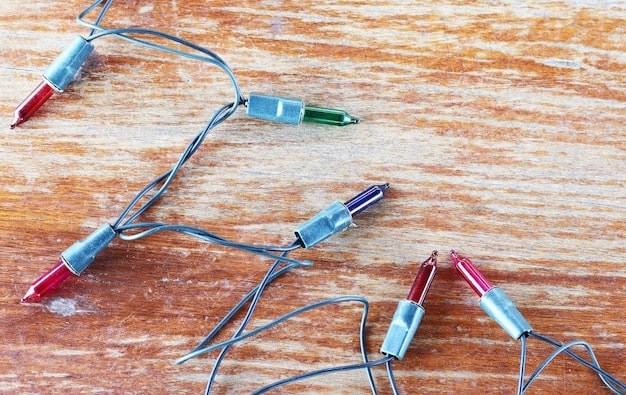
The Rise of Glitch Art in the US
The US has played a significant role in the popularization and evolution of glitch art. Several factors have contributed to its increasing visibility and acceptance within the American art scene.
Online Communities and Digital Culture
The internet has been instrumental in fostering a community around glitch art. Platforms like Tumblr, Instagram, and various online forums have allowed artists to share their work and connect with like-minded individuals.
Influence of Technology and Digital Natives
As digital technology becomes more ingrained in everyday life, especially among younger generations, the aesthetics of glitch art resonate deeply. Digital natives, who have grown up surrounded by technology, are more likely to appreciate and understand the nuances of digital errors.
- Increased Accessibility: Digital tools make glitch art creation accessible to a broader audience.
- Cultural Relevance: Glitch art reflects the realities of a digitally-dependent society.
- Youth Appeal: The unconventional aesthetics appeal to younger generations familiar with digital interfaces.
The rise of glitch art in the US is also tied to a broader cultural shift, where there is increasing appreciation for unconventional and experimental art forms. This has opened doors for glitch artists to exhibit their work in galleries and museums, further legitimizing the genre.
Glitch Art as High Art: Recognition and Acceptance
Glitch art’s transformation from a subculture phenomenon to a recognized form of high art is evident in its increasing presence in galleries, museums, and academic institutions.
Exhibitions and Galleries Featuring Glitch Art
Major art institutions across the US have started to showcase glitch art, recognizing its artistic merit and cultural relevance. These exhibitions provide a platform for glitch artists to reach wider audiences and gain critical acclaim.
Academic Interest and Scholarly Research
Universities and art schools are increasingly incorporating glitch art into their curriculum. Scholars are studying the philosophical and cultural implications of glitch art, contributing to its intellectual legitimacy.
- Institutional Recognition: Museums and galleries are showcasing glitch art exhibitions.
- Critical Acclaim: Art critics and scholars are analyzing and appreciating glitch art.
- Educational Integration: Universities and art schools are including glitch art in their curricula.
The acceptance of glitch art as high art reflects a broader shift in the art world, where traditional boundaries are being challenged and new forms of artistic expression are being embraced. It’s a testament to the power of digital art to push the boundaries of what is considered art.
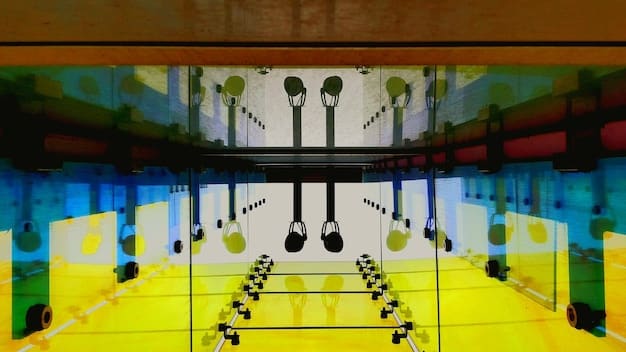
The Meaning and Interpretation of Glitch Art
Understanding the deeper meaning of glitch art requires an exploration of its cultural, philosophical, and technological contexts. It’s not just about creating aesthetically pleasing images or sounds; it’s about questioning the nature of reality and technology.
Criticism of Digital Perfection and Consumer Culture
Glitch art often serves as a critique of the relentless pursuit of digital perfection in consumer culture. By embracing errors and imperfections, it challenges the notion that technology must always be flawless and seamless.
Embracing Imperfection and the Unexpected
At its core, glitch art celebrates imperfection and the unexpected. It suggests that errors are not necessarily negative but can be sources of beauty and creativity.
- Challenging Norms: Glitch art questions the idea of digital perfection.
- Cultural Commentary: It reflects on societal reliance on technology.
- Artistic Expression: It redefines beauty by embracing imperfections.
The meaning of glitch art is also deeply intertwined with the experience of living in a digital age. It reflects the anxieties and uncertainties that come with constant technological change, while also celebrating the potential for creativity and innovation.
Glitch Art in 2025: Trends and Predictions
Looking ahead to 2025, several trends are likely to shape the future of glitch art. These trends include technological advancements, shifts in cultural attitudes, and the increasing integration of glitch art into various industries.
Integration with AI and Machine Learning
Artificial intelligence and machine learning are likely to play a significant role in the evolution of glitch art. AI algorithms can be used to generate complex glitch effects, opening up new possibilities for artists.
Influence on Design, Fashion, and Music
Glitch aesthetics are already influencing various industries, including design, fashion, and music. By 2025, this influence is expected to grow, with glitch art becoming a more prominent element in visual culture.
- AI-Driven Creation: AI will facilitate new forms of glitch art.
- Cross-Industry Impact: Glitch aesthetics will permeate various creative fields.
- Mainstream Adoption: Glitch art will become more widely recognized and appreciated.
The future of glitch art is also dependent on the continued evolution of digital technology. As technology continues to advance, new forms of errors and imperfections will emerge, providing artists with fresh inspiration and creative opportunities.
How to Create Your Own Glitch Art
Creating glitch art is more accessible than ever, thanks to a wide range of tools and resources available online. Whether you’re a seasoned artist or a beginner, there are plenty of ways to experiment with glitch techniques.
Software and Tools for Beginners
Several user-friendly software programs and online tools make it easy to create glitch art. These tools often provide intuitive interfaces and a range of pre-set glitch effects.
| Key Point | Brief Description |
|---|---|
| 🎨 Origins of Glitch Art | Emergence from early computing and video art experimentation. |
| 💻 Techniques | Data bending, hardware manipulation, and software exploitation explained. |
| 🖼️ Mainstream Rise | Influence of online communities and digital culture in the US. |
| 🔮 Future Trends | Integration with AI, implications for design, fashion, and music by 2025. |
Frequently Asked Questions About Glitch Art
▼
Glitch art is the artistic practice of using errors, bugs, and unintended anomalies in digital or analog systems to create visual or auditory effects. It’s about finding beauty in the unexpected.
▼
Technology has provided both the tools and the inspiration for glitch art. Digital tools allow for easy manipulation, while the pervasiveness of technology normalizes the idea of digital errors.
▼
Glitch art is increasingly featured in galleries and museums across the US, as well as online platforms. Check local art listings and online art communities for examples.
▼
Glitch art often questions the concept of digital perfection and explores the aesthetics of failure. It can be seen as a critique of consumer culture and technological dependence.
▼
Start by exploring user-friendly software and online tools. Experiment with different techniques, such as data bending and image corruption, to find your own unique style. Many online tutorials are available.
Conclusion
As glitch art continues to evolve and influence various aspects of visual culture, its role in challenging traditional artistic norms and questioning our relationship with technology becomes increasingly significant. By 2025, we can expect to see even greater integration of glitch aesthetics in art, design, and beyond, solidifying its place as a legitimate and thought-provoking art form.
